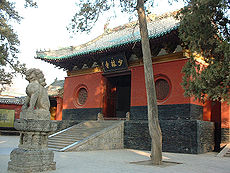- Wu Ta-hsin
-
Wu Ta-hsin Traditional Chinese 吳大新 Transcriptions Mandarin - Hanyu Pinyin Wú Dàxīn - Wade–Giles Wu2 Ta4-hsin1 Cantonese (Yue) - Yale Romanization Ng4 Daai6 San1 Part of the series on
Chinese martial artsList of Chinese martial arts Terms Historical places - Shaolin Monastery (少林寺)
- Wudang Mountains (武當山)
- Mount Hua (華山)
- Mount Emei (峨嵋山)
- Kunlun Mountains (崑崙山)
Historical people - Five Elders (五祖)
- Yim Wing-chun / Yan Yongchun (嚴詠春)
- Hung Hei-gun / Hong Xiguan (洪熙官)
- Fong Sai-yuk / Fang Shiyu (方世玉)
- Dong Haichuan (董海川)
- Yang Lu-ch'an (楊露禪)
- Wu Quanyou (吳全佑)
- Ten Tigers of Canton (廣東十虎)
- Chen Fake (陳發科)
- Chan Heung / Chen Xiang (陳享)
- Wong Fei-hung / Huang Feihong (黃飛鴻)
- Sun Lu-t'ang (孫祿堂)
- Huo Yuanjia (霍元甲)
- Yip Man / Ye Wen (葉問)
- Wang Zi-Ping (王子平)
- Bruce Lee / Li Xiaolong (李小龍)
- Jackie Chan / Cheng Long (成龍)
- Sammo Hung / Hong Jinbao (洪金寶)
- Yuen Biao / Yuán Biāo (元彪)
- Jet Li / Li Lian Jie (李連杰)
- Donnie Yen / Zhēn Zǐdān (甄子丹)
Legendary figures - Bodhidharma / Putidamo / Damo (菩提達摩)
- Zhang Sanfeng (張三丰)
- Eight immortals (八仙)
Related Wu Ta-hsin (1933–2005) was a Chinese t'ai chi ch'uan teacher who lived most of his life in Hong Kong. He was the great-grandson Wu style t'ai chi ch'uan founder Wu Ch'uan-yu and the grandson of the well-known teacher Wu Chien-ch'uan.[1] He directed the Wu family's lineage for four years from the Wu family headquarters in Hong Kong after the death of his cousin Wu Yen-hsia.[1]
Born into a Manchu military family known for their contributions towards preserving knowledge of the traditional Chinese martial arts, Wu Ta-hsin endured strict training from his grandfather Wu Chien-ch'uan, uncle Wu Kung-i and father Wu Kung-tsao.[1][2] He eventually became known as a teacher and for his expertise with the t'ai chi sabre and sword as well as for his qigong and pushing hands skills.[1]
When Wu Kung-i moved with his family to Hong Kong in the 1940s, Wu Ta-hsin assisted him in the promotion and teaching of t'ai chi ch'uan.[2] During the 1950s, at the direction of Wu Kung-i, Wu Ta-hsin and his cousins Wu Ta-kuei and Wu Ta-ch'i often travelled to Malaysia and Singapore to start and manage several Wu style academies.[1] Later in his life, he also travelled extensively to North America, teaching t'ai chi ch'uan in Toronto, Detroit and Vancouver.[1]
Generational senior instructors of the Wu family
1st Generation
- Wu Ch'uan-yü (Wu Quanyou, 吳全佑, 1834–1902), who learned from Yang Lu-ch'an and Yang Pan-hou, was senior instructor of the family from 1870-1902.
2nd generation
- His oldest son, Wu Chien-ch'üan (Wu Jianquan, 吳鑑泉, 1870–1942), was senior from 1902-1942.
3rd Generation
- His oldest son, Wu Kung-i (Wu Gongyi, 吳公儀, 1900–1970) was senior from 1942-1970.
3rd Generation
- Wu Kung-i's younger brother, Wu Kung-tsao (Wu Gongzao, 吳公藻, 1903–1983), was senior from 1970-1983.
3rd Generation
- Wu Kung-i's younger sister, Wu Ying-hua (Wu Yinghua, 吳英華, 1907–1997), was senior from 1983-1997.
4th Generation
- Wu Kung-i's daughter, Wu Yen-hsia (Wu Yanxia, 吳雁霞, 1930–2001) was senior from 1997-2001.
4th Generation
- Wu Kung-tsao's son, Wu Ta-hsin (Wu Daxin, 吳大新, 1933–2005), was senior from 2001-2005.
5th Generation
- The current senior instructor of the Wu family is Wu Ta-k'uei's son Wu Kuang-yu (Wu Guangyu, Eddie Wu, 吳光宇, born 1946).
References
- ^ a b c d e f Cai, Naibiao (2006). In Memory of Wu Daxin - Journal of Asian Martial Arts Vol. 15 No. 1. Via Media Publishing, Erie Pennsylvania USA. ISSN 1057-8358.
- ^ a b Yip, Y. L. (Autumn 2002). Pivot – Qi, The Journal of Traditional Eastern Health and Fitness Vol. 12 No. 3. Insight Graphics Publishers. ISSN 1056-4004.
External links
- Wu Ta-hsin (Wu Daxin) demonstrating Wu style pushing hands applications
- International Wu Style Tai Chi Chuan Federation website
- Detroit, Michigan Wu style website

This Chinese biographical article related to martial artists is a stub. You can help Wikipedia by expanding it.


